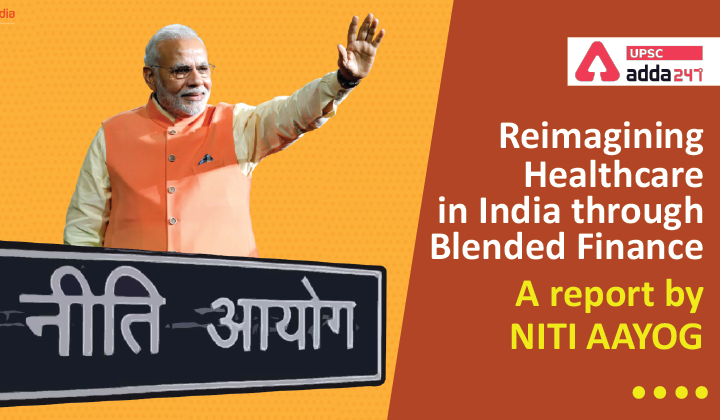Table of Contents
Blended Finance: Relevance
- GS 2: Issues relating to development and management of Social Sector/Services relating to Health, Education, Human Resources.
Blended Finance In India: Context
- Recently, NITI Aayog has unveiled a white paper on ‘Reimagining Healthcare in India through blende finance’ to improve access to affordable and quality healthcare.
Reimagining Healthcare in India through Blended Finance: Key points
- Atal Innovation Mission (AIM), NITI Aayog, and the U.S. Agency for International Development (USAID) has announced a new partnership under the Sustainable Access to Markets and Resources for Innovative Delivery of Healthcare (SAMRIDH) initiative.
- Objective: To improve access to affordable and quality healthcare for vulnerable populations in tier-2 and tier-3 cities, and rural and tribal regions.
- In 2020, USAID, IPE Global, and stakeholders from the Indian government, academia, and the private sector developed the innovative SAMRIDH blended finance facility to combine public and philanthropic funds with commercial capital to create and rapidly scale market-based health solutions.
- AIM and SAMRIDH will leverage philanthropic capital, and public sector resources to offset barriers for commercial investments in small and medium health enterprises to invest in and scale healthcare solutions.
- Reimagining Healthcare offers approaches to leverage innovative financing mechanisms to improve healthcare services for India’s most vulnerable populations.
- The collaboration will focus on innovations across the healthcare landscape with the common goal to mount an effective response to the ongoing third wave of COVID-19 and build health system preparedness for future infectious disease outbreaks and health emergencies.
What is blended finance?
- Blended finance is an approach towards financing where catalytic funding (e.g., grants and concessional capital) from public and philanthropic sources is utilized to mobilize additional private sector investment to realize social goals and outcomes.
- Blended finance is the strategic use of concessional capital and private capital in projects where the perceived risks are too high for private players to participate alone.
Blended finance benefits
- Addresses main barrier of private investors: Blended finance addresses the main barrier of private investors, which is the high perceived risk on an investment opportunity, and the poor returns for the given risk relative to comparable investments.
- Help achieve social goal: By reducing dependency on government debt and sovereign guarantee, and building a pipeline of commercially viable social impact projects.
- Valuable tool: Blended finance is a valuable tool for bilateral and multilateral agencies, philanthropic organizations, and Corporate Social Responsibility (CSR) foundations to complement traditional grant-making and invest their monies in the form of loan/equity/guarantee in projects that deliver financial and social returns.
Also Read:





 TSPSC Group 1 Question Paper 2024, Downl...
TSPSC Group 1 Question Paper 2024, Downl...
 TSPSC Group 1 Answer key 2024 Out, Downl...
TSPSC Group 1 Answer key 2024 Out, Downl...
 UPSC Prelims 2024 Question Paper, Downlo...
UPSC Prelims 2024 Question Paper, Downlo...





